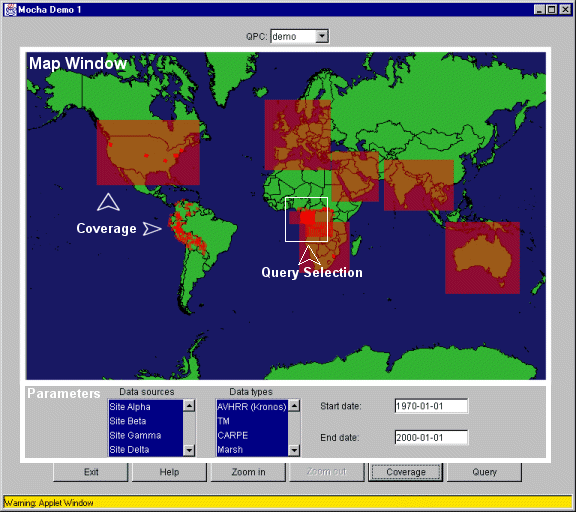| Overview |
| Components |
| Client API |
| QPC |
| DAP |
| Data Server |
| Plug-And-Play |
| Catalog |
| Benefits |
| Home |
Client Application
To provide support for a wide spectrum of users, MOCHA supports three kind of client applications:
- Applets
- Servlets
- Stand-alone Java applications
We expect applets to be the most commonly deployed clients in MOCHA, mainly used as the GUI to pose queries against the data collections and visualize their results. Figure 2 shows a screen shot of an applet that we have develop for the NASA ESIP Facility at the University of Maryland. This applet allows users to extract and visualize satellite AVHRR raster images from land regions, and polygons covering GIS features such as cities, lakes or states. Now, since there might be users who prefer or require a purely HTML-based interface, MOCHA provides the alternative of using a servlet as entry point into the system. The servlet receives the request and dynamically produces HTML documents containing the query results. Alternatively, the servlet might generate XML documents, which might later be converted to HTML at the Web browser. Finally, stand-alone Java applications will likely be used by users such as administrators or software developers, who will need to carry out complex tasks such as system configuration and tuning, data cleaning and backups, catalog management and distributed software debugging.
MOCHA provides a set of Java libraries containing the APIs needed by the client application to pose queries to MOCHA and retrieve their results. In particular, MOCHA provides a JDBC 2.0 complaint driver with support for user-defined types. We used such JDBC driver to implement the client application shown in Figure 2. It is important to point out that these client APIs also contain the infrastructure needed by the client application to load the user-defined Java classes that are needed to manipulate the query results. These Java classes are automatically delivered to the client by MOCHA at run time.

Figure 2: NASA ESIP Client
PREVIOUS NEXT
© 2000 University of Maryland. All rights reserved.

